Know your skin

Anatomy of the skin
In this article, we are trying to make you take the first step in skin care. And we will help you in this way as you deserve It is necessary to be successful in the path of beauty and rejuvenation with a general knowledge of the skin structure and then a complete knowledge of your skin type.
The skin is the largest organ of the body, which is more than 30000 cm and can
• Protect muscles, bones, nerves and veins
• It has the duty of protection against external damage, microscopic organisms, etc
• It also protects internal organs by receiving sensations such as heat, cold, pressure and pain.
• The skin is responsible for the appearance of beauty.
• Absorption of nutrients and disposal of waste materials are important responsibilities of the skin
• Skin absorption is very partial from fat tissue.
•Body temperature regulation
•vitD synthesis
Skin thickness ← 1-4 mm
weight ←3-4 kg
The skin of the body and face consists of three main parts: epidermis, mesoderm, hypodermis
Epidermis
The outermost and thinnest layer of the skin, which has 5 layers, has no blood vessels and is nourished through diffusion
And its thickness is 75-150 micrometers.
It is renewed every 15-30 days in young people and 45-50 days in old people
The skin layers are as follows:
- Stratum Corneum
- Stratum Lucidum
- Stratum Granulosum
- stratum spinosum
- stratum Basale
part 2
Recognition of skin types:
Normal, dry, oily, combination, sensitive
Skin type depends on factors such as; The amount of fat and sweat production depends on the blood flow in the skin and the activity of the sebaceous glands
How to identify skin types:
1Test of washing the skin with detergent and a piece of paper
2. Lampwood
3. Appearance
Dry skin
It occurs due to the decrease in the secretions of the sebaceous glands and the loss of water on the surface of the skin.
Characteristics of dry skin
ü The person feels stretched and dry after washing
ü Sensation of itching and sometimes burning and burning
ü Small flakes and cracks
ü Closed skin pores
ü No acne and scars
Dry skin problems
Fat-free/water-free
Dry skin care
Both hydration and fat
Dry skin is often thin, but not all thin is dry.
If the skin is dry due to the sun or it has thickened, you can use exfoliators such as AHA and BHA
used.
For quick treatments of dryness, exfoliators and moisturizers can be used at the same time.
Oily skin
Oily skin has the following characteristics
: shiny
ü Has open ratio pores
ü There are traces of acne, blackheads and whiteheads and scars on the skin.
ü It gets cloudy and dirty quickly
ü It is slippery
ü The skin is uneven and uneven
ü Effects of aging and wrinkles appear later
ü They have a thicker stratum corneum
Causes of oily skin
- Excessive secretion of sebum
- Hereditary or genetic
- Excessive washing (faulty cycle)
- Hormone → increase in androgens in women (polycystic ovary)
- Inappropriate deletion
- Improper makeup
Normal skin
Skin with enough moisture and without blemishes, without blackheads and whiteheads
Also, it does not feel dry and stretched
combination skin
They usually have oily or dry Tzone.
For these people, they should use moisturizers suitable for oily skin.
Sensitive skin
Thin skins that are sometimes allergic with tiny pores and visible capillaries.
which usually happens with age or as a result of sunlight
part 3
Skin problems
Open skin pores: This problem is usually seen in oily skin and the cause can be a weakness in the detergent or cleanser, which causes the pores to widen due to accumulation of fat secretion.
wrinkle:
With the increase due to thinning of the skin, change of elastin fibers, reduction of collagen, excessive dryness, the skin becomes old and wrinkled
Dullness of the skin
Thickening of the stratum corneum and keratin of the skin causes dullness.
Factors to increase stratum corneum: internal factors (age)
environmental factors (polluted air and lack of detergent
Cracked skin
Excessive dryness or size change is the cause of cracking
Using a moisturizer can be helpful
Malesma (Chloasma) → Hormonal spots such as pregnancy, cysts, etc., forehead and cheeks **
PIH → Stains caused by damage such as microneedling, acid, etc.
Causes of stains:
sunshine
age increasing
Acne scars
scar
Lack of melanocyte coordination in melanin production
There are different ways to treat spots, the safest way is to use compounds containing arbutin, which affects the tyrosinar enzyme and reduces the melanin color
Acne:
cane acne is a Greek word meaning point
It is a chronic and multinoctorial disorder of the pilosebaceous unit of the skin. 80% occurs in the treatment of puberty. Acne starts at the age of
10-13
